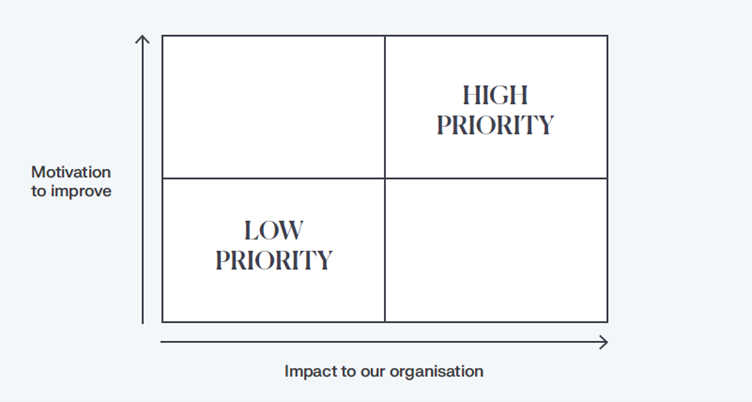360-degree feedback provides constructive insights to expand self-awareness, boost performance, enhance leadership abilities and improve wider business outcomes. But to unlock these benefits they need to be carried out effectively and then acted upon appropriately.
Research shows a clear link between leadership effectiveness and employee engagement. In fact, more than 85% of Fortune 500 companies use 360-degree (or multi-rater) feedback as a key part of their leadership development process, according to industry expert Jack Zenger. In this blog, we explain some of the key considerations and challenges related to collecting 360 feedback and how to plan and take subsequent actions to improve your leadership performance.
The key considerations when collecting 360-degree feedback
The 360 feedback review process is based on evaluation from peers, team members, direct reports and sometimes customers, alongside superiors and the leader themselves. This makes it vital that all raters:
- Are clear about the purpose of the evaluation and how to give multi-rater feedback.
- Are adequately trained and understand what they are evaluating.
- Understand that the feedback, which should be constructive, will be anonymous.
- Know that the aim is to drive positive improvement by evaluating behaviours and competencies – it is not a traditional performance review.
- Are clear that 360-degree feedback processes should not be impacted by emotion or any existing relationships that they have with the leader they’re rating.
Additionally, the 360 feedback survey should be focused on the right criteria, have a mix of rating scales and open-ended questions, be easy to understand and simple to fill in by all raters and be focused on the particular organisation and the leader’s role.
Bear in mind that if the exercise feels irrelevant to either the rater or the leader it won’t get full buy-in and attention. Finally, look to carry out 360-degree feedback exercises more than once a year – regular evaluations enable more constant improvement in leadership development and make collecting and acting on feedback a central part of the overall company culture.
Taking effective action to improve leadership
Simply reviewing, understanding and internalising the results of 360-degree evaluations can improve leadership performance. However, a well-thought-out and executed development plan can provide a clear path to even greater improvements, as turning results into a specific set of goals and actions helps support the behavioural changes required to improve leaders’ performance.
Receiving feedback can be hard, and change requires not only a level of personal commitment, but also an awareness of what it takes to change, and the obstacles that need to be overcome. If it was easy to demonstrate all the competencies of a transformational leader, you would see only strengths in your results. And it’s unlikely, even for a great leader, that this will be the case. There’s generally a mix of strengths and weaknesses identified in a 360-degree feedback review.
Prioritising your 360-degree feedback efforts

One technique that can help leaders to focus on the right areas for development is to work on an ‘Impact/Motivation’ quadrant. These look to drive change in areas leaders are most motivated to improve upon, and which are also perceived to have the highest impact on performance.
To develop your own Impact/Motivation quadrant, follow these steps:
- Ask yourself which leadership competencies you feel most willing and able to change. Rather than just going straight to your lowest scoring 360-degree feedback areas, think about what you want to improve and what would be easiest to change.
- Ask your raters to consider these same leadership competencies and decide which they believe would allow you to have the greatest impact on overall business performance.
- Chart all leadership competencies on your quadrant. When you build your development plan, look first at those competencies that you have rated most highly for both motivation and performance impact (be that your own, your team’s or your organisation’s).
How to ensure success when implementing change based on 360-degree feedback
Developing or improving upon competencies can be difficult as, in most cases, this means changing your behaviour. As behaviours become more ingrained, they can become resistant to change, but there are things that leaders can do to maximise the chance of success.
Here are our recommendations for ensuring success when implementing change from the 360-degree feedback you’ve gathered and evaluated:
- Try not to focus on too many goals or actions at any point in time.
- Ensure that behavioural outcomes of your goals or actions are visible and can (where possible) be measured.
- Don’t make your goals or actions too lengthy. Split longer goals into shorter, achievable chunks.
- Get support from others. Consider getting a coach or mentor to help you work through your action plan.
- Set up a system of accountability. This can be as simple as sharing your action plan with others or setting up regular peer or manager meetings to review your progress.
- Get regular feedback. As you work through your action plan, seek additional feedback from your original raters to see if they’re perceiving the changes you’re making in a positive way.
- Don’t stop. There is always room for improvement. Once you have worked through your first set of goals/actions, identify your next areas of focus.
Conclusion
As we’ve outlined in other articles on leadership, 360-degree feedback is an essential part of developing self-awareness and underpins both better employee performance and business improvements. As with every feedback exercise, success requires a clear process, normally led by the HR department, and buy-in from everyone involved to provide honest feedback – and then act on it.
No leader is perfect. A 360 feedback approach enables you to take action to constantly improve, now and in the future. Tivian’s Tivian’s Leadership 360 tool can support your efforts and empower your business with the tools to gather the right feedback to develop your leaders and make informed decisions that drive positive change. Learn more about our leadership solution.


